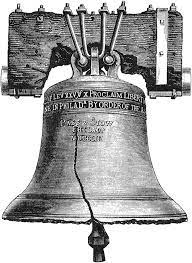Song of the Bell (1799) F. Shiller I call the living • I mourn the dead • I break the lightning
 The Song of the Bell by Friedrick Shiller published in 1799 as interpreted
by Marianna Wertz who was vice-president of the Schiller Institute. Later used by Beethoven in his 9th Symphony A Fugue in Four Voices The poem is a fugue in four principal parts,
which interact and jointly develop, much as voices do in a fugal composition by
Bach or Mozart. The first voice is the technological process of forging a
great bell. The second voice, for which the bell is also a metaphor,
deals with the development and life of the individual. The third voice concerns
questions of statecraft and the French Revolution, in which the subjects of the
first and second voices are placed in the larger, universal context. The fourth
voice, which enters for the first time in the person of the poet, introduces
Schiller’s method to ensure the success of republican revolutions.
The Song of the Bell by Friedrick Shiller published in 1799 as interpreted
by Marianna Wertz who was vice-president of the Schiller Institute. Later used by Beethoven in his 9th Symphony A Fugue in Four Voices The poem is a fugue in four principal parts,
which interact and jointly develop, much as voices do in a fugal composition by
Bach or Mozart. The first voice is the technological process of forging a
great bell. The second voice, for which the bell is also a metaphor,
deals with the development and life of the individual. The third voice concerns
questions of statecraft and the French Revolution, in which the subjects of the
first and second voices are placed in the larger, universal context. The fourth
voice, which enters for the first time in the person of the poet, introduces
Schiller’s method to ensure the success of republican revolutions.The opening Latin invocation betrays Schiller’s thinking: “I call the
living, I mourn the dead, I break the lightning.” The leading symbol of the
American Revolution in Schiller’s time was the great Liberty Bell of
Philadelphia, which pealed in 1776 to proclaim the signing of the Declaration
of Independence. And Benjamin Franklin, known throughout Europe as the man who
“broke the lightning”—the American Prometheus—was the living symbol of that
Revolution for all European republicans. Franklin was the single most important
link between the American Revolution and those French republicans, like
Lafayette, Turgot, Carnot, and Lavoisier, who attempted to bring into being a
constitutional monarchy in France, as the mediation for a constitutional
republic. Turgot wrote of Franklin, in words which echo Schiller’s, “Eripiut
coelo fulmen sceptrumque tyrannis” (“He has snatched the lightning from the
heavens, and the scepter from tyrants”). But the Bell is more than a
metaphor for the American Revolution. The reader is struck from the outset of
the poem with Schiller’s meticulous description of the actual 37 Schiller’s
metaphorical use of lightning—as both creative power and destructive natural
force—drew on familiarity with the republican scientist Benjamin Franklin.
Above: Benjamin West, “Benjamin Franklin Drawing Electricity from the Sky,”
1816. Philadelphia Museum of Art: Gift of Mr. and Mrs. Wharton Sinkler
technology of bell-founding. Was his purpose to educate his readers
about how to forge a bell? Hardly! His purpose was to forge a republican
citizenry. Schiller points to the underlying purpose of the bell founding
metaphor in the second stanza: This it is, what all mankind graced, And to this
end to understand That he in inner heart so traced, What he created with his
hand. For Schiller, man is the creator of his own destiny, “though the blessing
comes from higher.” The forging of a bell, like the forging of a
republic, will succeed only when man uses his “understanding” to be like the
Creator. The bell itself, therefore, is not just a poetic metaphor for the
American Revolution. Much more fundamentally, Schiller uses the bell as a
metaphor to demonstrate that a republican revolution is only possible
through the application of the same noetic processes that go into the creation
of new technologies.


Comments
Post a Comment